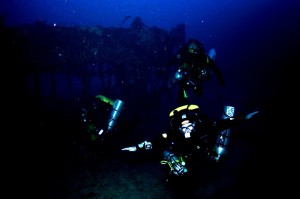News
At 100 metres, no one can hear you scream… but can they hear you sing?
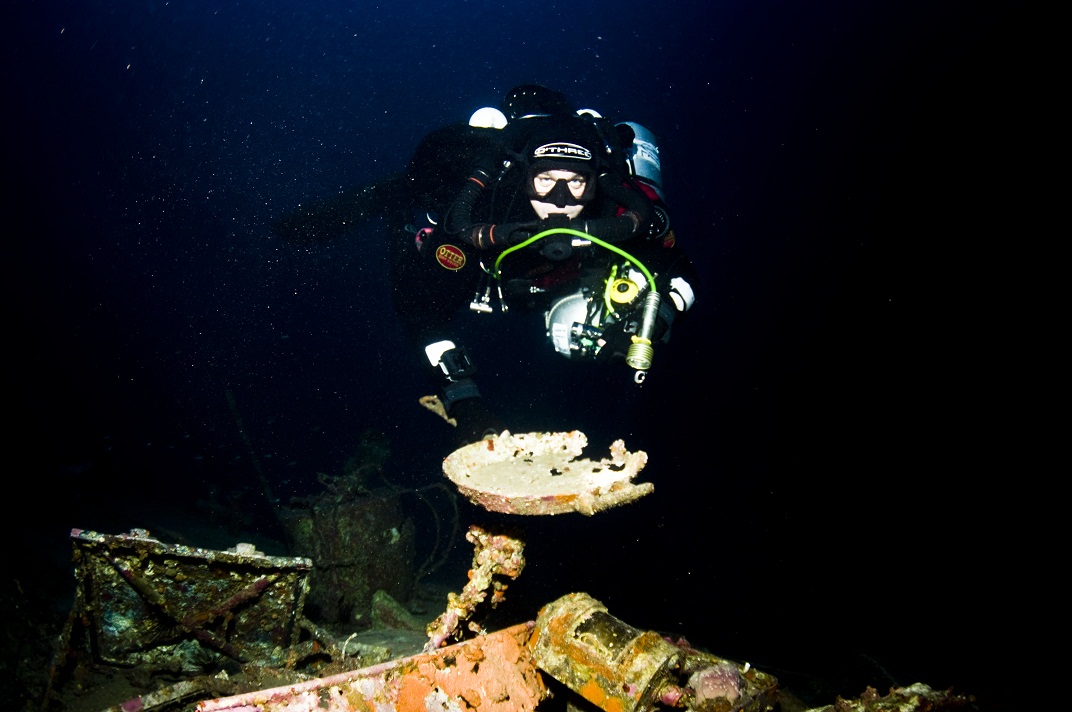
The Mile High Club. Ever heard of it?
The 100 Metre Club. Ever heard of that?
Which one is more risky?
Which one is more achievable, more probable, more plannable?
Well it isn’t the Boeing 747 option with the toilet roll holder stuck up your backside and a pair of tights strangling you and one stray big toe constantly hitting the attendant call button.
Getting to the Big One Hundred takes far more courage and a lot more planning, it’s a hell of a lot less risky and a lot less embarrassing if you get caught doing it. It used to be only deep explorers that went as deep as 100 metres; now 100m divers are high-tec divers, and without diminishing the achievement of planning and executing a dive of this calibre, a little bit more common.
It is still a very exclusive club, one that I would like you all to join. There are no guarantees that you will be able to get there (in terms of your ability), but with the right understanding, desire, training and experience, I do believe that the 100 metre club could be a lot bigger. The funny thing here is that most of the girls reading this article are thinking that it’s a waste of time to read further. Well, in my opinion, you are the future big deep hairy (and I’m not referencing armpits, legs or Brazilians here) tech divers. Girls struggle less with peer pressure, they are calm under fire and most importantly, they breathe a whole lot less gas. More gas means more time. More time means more exploration.
So how exactly do you get there?
In previous articles I have written about choosing the instructor and training agency, also whether you are going to be an Open Circuit or Closed Circuit technical diver. The most important decisions after those are, do you need to go to 100 and why? I don’t believe in just doing a dive to 100 metres for the hell of it, I believe we should have an objective. For me, that usually means a wreck or some beautiful topography, as I’m afraid to say it is not teeming with fish down there. If you will never use the skills learned on this course again, then it seems like a real waste.
Doing the dive
You do not need to dive to 100 on your training course; in fact some agencies do not allow it, however I believe that it is a very good thing to do. My reasoning is empirical really. I have qualified a fair few Trimix divers now, and when a divers depth timer/computer hits triple figures, there is something that changes within that diver, as recounted by Alex Griffin of Diving Leisure London:
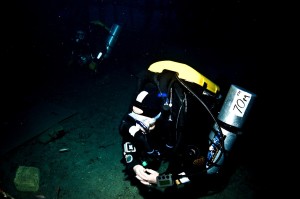 “As a reasonably experienced diver and instructor I find that the most excitement I draw from recreational diving comes from either diving in environments or places substantially different from those I’ve dived before or from seeing the enjoyment in the faces of those that I teach.
“As a reasonably experienced diver and instructor I find that the most excitement I draw from recreational diving comes from either diving in environments or places substantially different from those I’ve dived before or from seeing the enjoyment in the faces of those that I teach.
“In some ways I’ve come to miss that nervous excitement that comes from being on a boat heading out to a dive, knowing that your limits and abilities are about to challenged.
“When I completed my IANTD Trimix course with Diving Matrix in Malta I perfectly re-captured that feeling as I went out to complete my 100m qualifying dive. This is an experience that you know is going to be monumental. I enjoyed the anticipation of knowing I was about to do something I’d never done before, that was a major challenge – but also knowing I was capable of pulling it off.
“The dive itself went without a hitch. The sensation of looking at your computer and seeing 100m on the display is pretty mind boggling. We also had the privilege of completing the dive on a massive unidentified cargo ship and we had a few minutes to explore the bow. That was incredible; to actually be at a 100m and ‘doing a dive’ was, for me, the highlight of the experience. The decompression schedule was surprisingly light and the whole dive took only an hour; I returned to the surface feeling a mix of awe, triumph and extreme happiness.
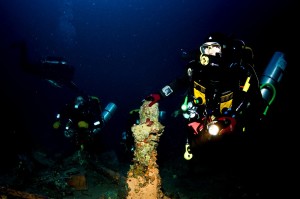 “Going back in to harbour I realised that this is why I love scuba diving so much; no matter who you are or how much experience you have, there is always something new to see or do that will keep you feeling just like you did when you first put your head under the water.”
“Going back in to harbour I realised that this is why I love scuba diving so much; no matter who you are or how much experience you have, there is always something new to see or do that will keep you feeling just like you did when you first put your head under the water.”
I believe it is best to experience your first 100 metre dive under the watchful eye of an experienced deep Trimix instructor, so pick your Trimix instructor with as much caution as you chose your entry level instructor… as you are about to turn your world on its head.
What about the training?
The training is actually not that hellish. You will have to go through a series of courses before you get the prerequisites for Full Trimix. I can assure you of one thing, every one of the courses is an absolute blast.
Beginning with Advanced Nitrox (and Deco procedures, depending on agency), which teaches you basic twinset, long hose and stage cylinder management. This course teaches minimal deco and about a 40 odd metre depth maximum.
Next you have an Extended Range (Tec Deep) or Normoxic (breathable at the surface) Trimix. On this course deco is dramatically increased and a max depth of around 60 metres can be achieved.
And finally you are eligible for full blown Trimix. This is an unlimited deco, multi stage 100 metres maximum depth programme (some agencies like DSAT are 75 metres).
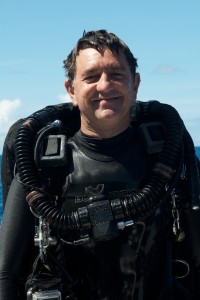 On completion of the dive I do believe that life changes a little. Something in your soul lights up like a little beacon. I felt like I had journeyed to another galaxy like an extreme explorer, and I suppose I did. Not that many people even peer underwater using a mask and snorkel, let alone dive to 100 metres, so I guess I had been to another galaxy. I certainly looked like I was going into space. Sadly, the world’s media were not there to meet me when I surfaced grinning like a Cheshire cat. I was not put into the hall of fame along side Neil Armstrong and Buzz Aldrin, but there is a champagne bottle in my local pub that has 11 ATA (11 atmospheres) printed in silver along it’s side on the top shelf as you walk in the door. All my friends came out to celebrate with me, and for a few fleeting moments I became the explorer I had always dreamed I would be.
On completion of the dive I do believe that life changes a little. Something in your soul lights up like a little beacon. I felt like I had journeyed to another galaxy like an extreme explorer, and I suppose I did. Not that many people even peer underwater using a mask and snorkel, let alone dive to 100 metres, so I guess I had been to another galaxy. I certainly looked like I was going into space. Sadly, the world’s media were not there to meet me when I surfaced grinning like a Cheshire cat. I was not put into the hall of fame along side Neil Armstrong and Buzz Aldrin, but there is a champagne bottle in my local pub that has 11 ATA (11 atmospheres) printed in silver along it’s side on the top shelf as you walk in the door. All my friends came out to celebrate with me, and for a few fleeting moments I became the explorer I had always dreamed I would be.
Become all that you want to be, that’s really all this article is about. If you fancy doing 100 metres then go out and talk to an Instructor and let them help you realise your dreams.
Paul is the Director of Training at RAID. To find out more about the courses that RAID offers, visit www.diveraid.com.
Blogs
Northern Red Sea Reefs and Wrecks Trip Report, Part 2: Wall to Wall Wrecks

Jake Davies boards Ghazala Explorer for an unforgettable Red Sea diving experience…
The second day’s diving was a day full of wreck diving at Abu Nuhas, which included the Chrisoula K, Carnatic, and Ghiannis D. The first dive of the day was onto the Chrisoula K, also known as the wreck of tiles. The 98m vessel remains largely intact where she was loaded with tiles which can be seen throughout the hold. The stern sits at 26m and the bow just below the surface. One of the highlights of the wreck is heading inside and seeing the workroom where the machinery used for cutting the tiles are perfectly intact. The bow provided some relaxing scenery as the bright sunlight highlighted the colours of the soft coral reef and the many reef fish.

Following breakfast, we then headed to the next wreck, which was the Carnatic. The Carnatic is an 89.9m sail steamer vessel that was built in Britain back in 1862. She ran aground on the reef back in 1869 and remains at 27m. At the time, she was carrying a range of items, including 40,000 sterling in gold. An impressive wreck where much of the superstructure remains, and the two large masts lay on the seafloor. The wooden ribs of the hull provide structures for lots of soft corals, and into the stern section, the light beams through, bouncing off the large shoals of glass fish that can be found using the structure as shelter from the larger predators that are found outside of the wreck.

The final wreck at Abu Nuhas was the Ghiannis D, originally called ‘Shoyo Maru,’ which was 99.5m long and built in Japan back in 1969 before becoming a Greek-registered cargo ship in 1980. The ship then ran aground on the reef on April 19th, 1983, and now sits at the bottom at a depth of 27m. Heading down the line, the stern of the ship remains in good condition compared to the rest of the hull. The highlight of the wreck, though, is heading into the stern section and down the flights of stairs to enter the engine room, which remains in good condition and is definitely worth exploring. After exploring the interior section of the ship, we then headed over to see the rest of the superstructure, where it’s particularly interesting to see the large table corals that have grown at the bow relatively quickly considering the date the ship sank. After surfacing and enjoying some afternoon snacks, we made sure everything was strapped down and secured as we would be heading north and crossing the Gulf of Suez, where the winds were still creating plenty of chop.

The next morning, it was a short hop to Ras Mohammed Nature Reserve for the next couple of days of diving. The 6am wake-up call came along with the briefing for the first site we would be diving, which was Shark & Yolanda. The low current conditions allowed us to start the dive at Anemone City, where we would drift along the steep, coral-filled wall. These dives involved drifts, as mooring in Ras Mohammed wasn’t allowed to protect the reefs. As a dive site, Shark & Yolanda is well-known and historically had a lot of sharks, but unfortunately not so many in recent years, especially not so early in the season. However, there was always a chance when looking out into the blue.

The gentle drift took us along the steep walls of the site, with plenty of anemone fish to be seen and a huge variety of corals. It wasn’t long into the dive before we were accompanied by a hawksbill turtle, who drifted with us between the two atolls before parting ways. Between the two reefs, the shallow patch with parts of coral heads surrounded by sand provided the chance to see a few blue-spotted stingrays that were mainly resting underneath the corals and are always a pleasure to see. With this being the morning dive, the early sunlight lit up the walls, providing tranquil moments. Looking out into the blue, there was very little to be seen, but a small shoal of batfish shimmering underneath the sunlight was a moment to capture as we watched them swim by as they watched us.

Towards the end of the dive, we stopped at the wreck of the Jolanda where the seafloor was scattered with toilets from the containers it was carrying. This provided a unique site to make a safety stop, which was also accompanied by a large barracuda slowly swimming by, along with a hawksbill turtle calmly swimming over the reef as the sun rays danced in the distance.
For the next dive, we headed north to the Strait of Tiran to explore the reefs situated between Tiran Island and Sharm El Sheik, which were named after the British divers who had found them. We started on Jackson before heading to Gordons Reef, where we also did the night dive. All the atolls at these sites provided stunning, bustling coral reefs close to the surface and steep walls to swim along, which always provided the opportunity to keep an eye out for some of the larger species that can be seen in the blue. Midwater around Jackson Reef was filled with red-toothed triggerfish and shoals of banner fish, which at times were so dense that you couldn’t see into the blue. Moments went by peacefully as we enjoyed the slow drift above the reef, watching these shoals swim around under the mid-afternoon sun.

The night dive at Gordon’s Reef was mainly among the stacks of corals surrounded by sand, which was great to explore under the darkness. After some time circling the corals, we came across what we were really hoping to find, and that was an octopus hunting on the reef. We spent the majority of the dive just watching it crawl among the reef, blending into its changing surroundings through changes in colour and skin texture. It’s always so fascinating and captivating to watch these incredibly intelligent animals, in awe of their ability to carry out these physical changes to perfectly blend into the reef. Before we knew it, it was time to head back to the boat to enjoy a well-deserved tasty dinner prepared by the talented chefs onboard.
Check in for the 3rd and final part of this series from Jake tomorrow!
To find out more about the Northern Red Sea reef and wrecks itineraries aboard Ghazala Explorer, or to book, contact Scuba Travel now:
Email: dive@scubatravel.com
Tel: +44 (0)1483 411590
Photos: Jake Davies / Avalon.Red
Marine Life & Conservation
Double Bubble for Basking Sharks

 The Shark Trust is excited to announce that, for two more days only, all donations, large or small, will be doubled in the Big Give Green Match Fund!
The Shark Trust is excited to announce that, for two more days only, all donations, large or small, will be doubled in the Big Give Green Match Fund!
Donate to Basking in Nature: Sighting Giants
The Shark Trust is hoping to raise £10k which will be doubled to £20k. This will go towards Basking in Nature: Sighting Giants. And they need YOUR help to reach they’re goal.
The Shark Trust’s citizen science project is to monitor and assess basking sharks through sightings; encouraging data collection, community engagement, and promoting nature accessibility. This initiative aims to enhance health and wellbeing by fostering a deeper connection with British Sharks.
Campaign Aims
- Increase citizen science reporting of Basking Sharks and other shark sightings to help inform shark and ray conservation.
- Provide educational talks about the diverse range of sharks and rays in British waters and accessible identification guides!
- Create engaging and fun information panels on how to ID the amazing sharks and rays we have on our doorstep! These can be used on coastal paths around the Southwest. With activities and information on how you can make a difference for sharks and rays!
- Promote mental wellbeing through increasing time in nature and discovering the wonders beneath the waves!
Donate, and double your impact. Click Here
-

 News3 months ago
News3 months agoHone your underwater photography skills with Alphamarine Photography at Red Sea Diving Safari in March
-

 News3 months ago
News3 months agoCapturing Critters in Lembeh Underwater Photography Workshop 2024: Event Roundup
-

 Marine Life & Conservation Blogs2 months ago
Marine Life & Conservation Blogs2 months agoCreature Feature: Swell Sharks
-

 Blogs2 months ago
Blogs2 months agoMurex Resorts: Passport to Paradise!
-

 Blogs2 months ago
Blogs2 months agoDiver Discovering Whale Skeletons Beneath Ice Judged World’s Best Underwater Photograph
-

 Gear Reviews2 months ago
Gear Reviews2 months agoGear Review: Oceanic+ Dive Housing for iPhone
-

 Marine Life & Conservation2 months ago
Marine Life & Conservation2 months agoSave the Manatee Club launches brand new webcams at Silver Springs State Park, Florida
-

 News3 months ago
News3 months agoWorld’s Best Underwater Photographers Unveil Breathtaking Images at World Shootout 2023


